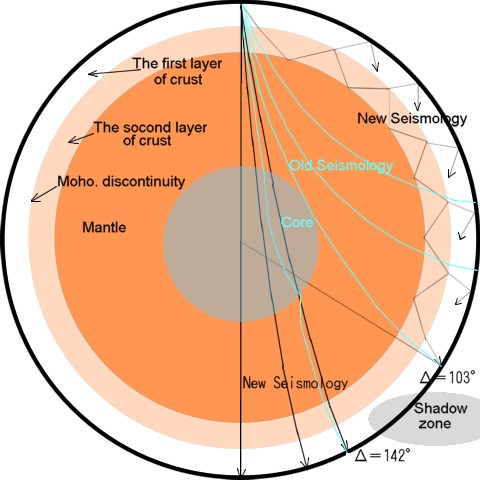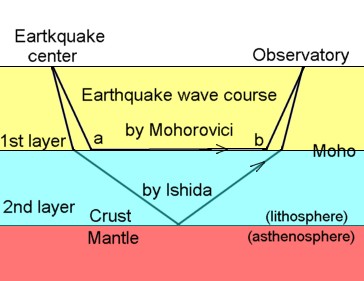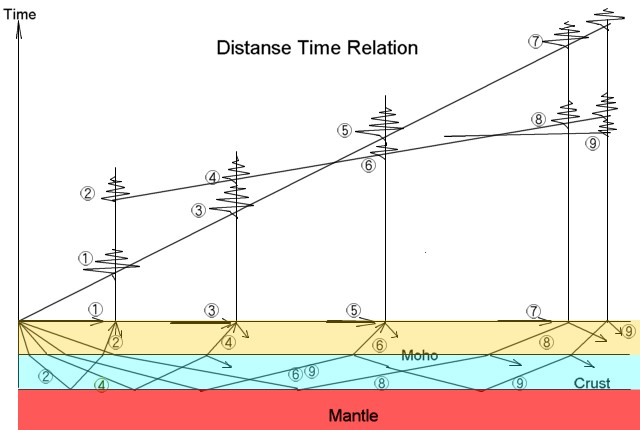| Learning from the seminar of the new seismology |
||||||||||||||||||||||
|
An earthquake wave doesn't pass in the mantle, and progresses on the crust.
|
||||||||||||||||||||||
| Fig.1 showed the passage course of the earthquake wave by the old theory and Ishida theory. The course of Ishida theory is in the crust, and the course of the old theory is in the mantle. | ||||||||||||||||||||||
 |
||||||||||||||||||||||
| Fig.1 Earthquake wave course inside the earth. A difference in the old theory and Ishida theory . |
||||||||||||||||||||||
| A blue line shows the course of the earthquake wave by the old theory. The area where a center angle is to 142° from 103° is the zone of the shadow which an earthquake wave doesn't reach. Effect on a lens by outer core and effect on refraction by innner core are presumed to explain the reason for an earthquake wave why not to do reach. Though outside core is a liquid, a mantle and the inside core are solids with old theory. When some phenomena are explained, there is contradiction in the mantle solid argument. For example, the earth keeps shaking after the big earthquake like a bell of the Buddhism temple for a while. If a mantle is a solid, it is unacceptable that the earth keeps shaking. Furthermore, won't the magnetic field of the earth occur because a mantle is a liquid and has convection? The existence of the ground magnetic field is thought the earth to show that it is living. It thinks that a mantle solid argument is wrong. It contradicts that a solid has convection. It can't think that a solid causes the convection which moves plate. As for Ishida theory, a crust is 2 layer structure. A crust corresponds to lithosphere of the plate tectonics argument. Therefore, though a crust is a solid, unlike the plate tectonics theory, mantle is liquid. Then, the reason why a shadow zone occurs is explained next. One end of the shadow zone is because earthquake wave energy declines in the point of 103°. One other end means that an arrival limit of the P wave is the point of 142°. |
||||||||||||||||||||||
 |
||||||||||||||||||||||
| Fig.2 A difference in the earthquake wave spread course by Mohorovici and Ishida . |
||||||||||||||||||||||
|
Fig2. shows the progress course of the earthquake wave which Mohorovici presumed and the course of Ishida theory. A wave to dive underground for a while is earlier than a wave to proceed through the ground from the earthquake center, and reaches an observation point. Fig2 explains a reason.The course of Mohorovici changes a course in the point a and the point b. Though a change in the point a means all reflection, a change in the point b can't be explained. Obviously it contradicts in the general wave motion theory . It can be understood as a mere general idea figure. A proper course is a course by Ishida which reflects it at the top of the liquid mantle. There won't be a big difference even in the course of Mohorovici consequently. The thought of Mohorovbici is not a big error as a reason why a travel-time line becomes a curve. But, the earthquake wave speed that it passes the 2nd layer is supposed to be earlier than 8km per hour because it proceeds through the longer distance than the course of Mohorovici. A result of a calculation of 8km per hour was supposed to run through the course of Mohorovici. An earthquake wave will proceed to the inside of the earth without reflecting at the top of the mantle if a mantle is a solid. But, as mentioned in the top, a mantle is a liquid, and the earthquake waves which can progress into the mantle are only some of the P waves. A S wave can't pass inside the liquid mantle. All the S waves pass through the crust.This means the failure of the investigation inside the earth by a mantle-tomography. |
||||||||||||||||||||||
 |
||||||||||||||||||||||
| Fig.3 The course of the earthquake wave by Ishida theory. The reason why distance time relations become curves | ||||||||||||||||||||||
|
Fig.3 explains the reason why the ditance-time relation becomes a curve precisely. The wave (for example, like a wave of 9) whose time to pass the second layer of the crust is long reaches an observation point early. A wave arrives early, and distance time relations are indicated with a curve in the distant observation point. |
||||||||||||||||||||||
| BACK | ||||||||||||||||||||||